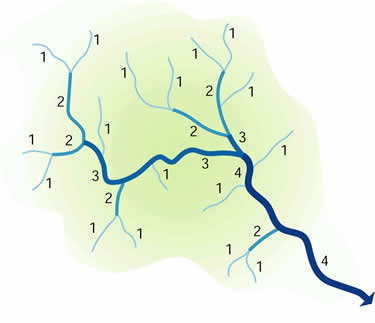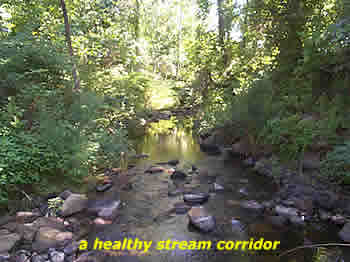
"1" = first order stream, "2" = second order stream, etc.
In Stream Corridor Restoration: Principles, Processes, and Practices (10/98).
Interagency Stream Restoration Working Group (15 federal agencies)(FISRWG).
IV. Streams and Riparian Buffers
Stream Classification and Order
Streams carry concentrated storm water runoff and discharged groundwater across the length of the watershed until it reaches its final destination; either a lake or reservoir or the ocean.
| The Three Basic Types of Streams: |
|---|
|
Stormwater runoff begins its journey as a thin sheet of water flowing across the surface of the land. As it flows down through the watershed, the flow becomes more and more concentrated until finally a small stream is formed. This beginning of a stream is called the stream's headwater. Each headwater stream is designated as a first order stream. When two first order streams combine together they produce a second order stream, two second order streams combine to produce a third order stream and so on. Only when two streams of the same order are combined does the stream order increase. Numerous lower order streams may enter a main stream without changing the stream order.

|
Stream ordering in a drainage network. "1" = first order stream, "2" = second order stream, etc. In Stream Corridor Restoration: Principles, Processes, and Practices (10/98). |
Immediately adjacent to, and extending away from a stream channel is an area that is critically important for protecting the integrity and maintaining a healthy stream. Called the stream's riparian buffer, this area needs to be maintained in a natural state, and of sufficient width, to ensure that activities occurring in the general vicinity of the stream, wetland or water body do not affect the health or integrity of the aquatic system. Buffers, maintained in a natural state, provide several benefits crucial to maintaining a healthy stream or wetland, including wildlife habitat and filtering pollutants. Forested buffers also help to reduce stream warming and in preventing stream bank erosion.

Urban development affects the frequency and magnitude of storm flows dramatically. Consequently, urban stream channels experience more bankfull and sub-bankfull flow events each year than they had prior to development (Center for Watershed Protection). As a result, both the bed and bank for a stream are exposed to highly erosive flows more frequently and for longer intervals. Streams typically respond to this change by becoming wider and/or deeper. This is a highly unstable condition for the steam and results in severe streambank erosion and habitat degradation.